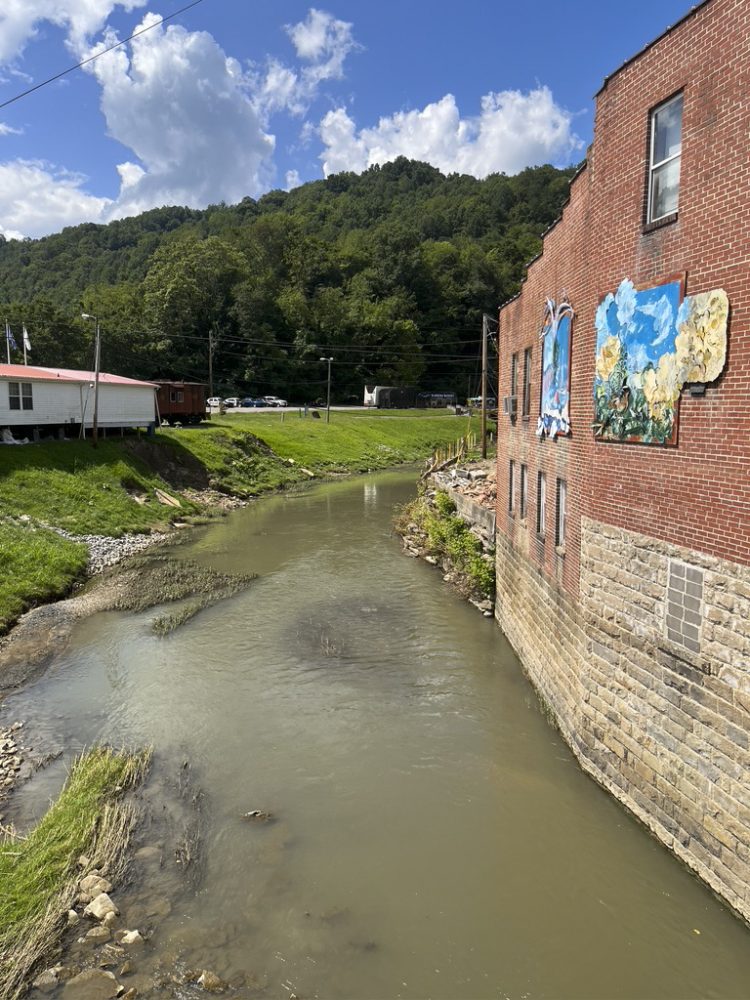WHITESBURG, Ky. — From the window of her family’s second-floor apartment, five-year-old Ophelia Carter saw the water rising.
Weeks earlier, Ophelia’s father had pointed out a snapping turtle in the shallow river that runs just yards away from their home in Whitesburg, Kentucky, a town of some 2,000 people.
But on July 28, the family watched as the North Fork of the Kentucky River rushed fast and muddy below a concrete bridge.
Carrie Carter and her daughter Ophelia, 5, outside their Whitesburg, Kentucky apartment. Their home was barely spared by the rising flood waters. Credit: Austyn Gaffney for The Hechinger Report
Around 8:15 a.m., the water level reached 16 feet, well above the previous flood record of 14.7 feet set in 1957. By 10 a.m., water flowed into town, reaching almost 21 feet before the gauge failed. The river pushed open the bottom door of their building and lapped at the second step to the apartment, before slinking away like a bad dream.
“It was kind of cool, kind of scary,” said Ophelia weeks later, while taking bites of barbecue chips at Heritage Kitchen, a restaurant a block away from her family’s apartment. Like her home, the restaurant was barely spared from the rising water.
While Ophelia colored a butterfly with neon crayons, her mom, Carrie Carter, said her daughter had taken the disaster fairly well, though she has begun sleeping with her parents more often. Everyone the family knew was affected, Carter said, through their homes, vehicles, immediate families, close friends, or workplaces.
“Everyone has a direct link to how awful this is,” Carter said.
“Everyone!” echoed Ophelia.
The catastrophic flooding in Eastern Kentucky this summer killed 40 people and damaged or destroyed over 10,000 homes. The floods also disrupted infrastructure, including power grids, water systems, and roads and bridges, for thousands more. The 25 impacted school districts reopened weeks past their normal schedule, and damage to schools in the region may top $100 million, said Gov. Andy Beshear in the days after the flooding.
A washed-out bridge in Perry County, Kentucky shows the impact of this summer’s devastating floods in the region. Credit: Austyn Gaffney for The Hechinger Report
Such disasters have become a familiar story, from megafires burning through communities in California to record heat waves forcing school closures in areas without air conditioning. Florida and Puerto Rico have both been left reeling after hurricanes. Aging buildings and deferred maintenance often leave schools uniquely vulnerable.
No one disaster can be linked directly to climate change, but experts agree that extreme weather events, like the downpours that shattered rainfall records in Eastern Kentucky, are becoming more common as the atmosphere warms. And here, the floods are already testing the resilience of a community that has been strained both from the pandemic and from a long-standing lack of investment after the coal economy dried up.
Related: How will flooding affect your school?
And while Kentucky is on the slow road to recovery, new weather events are stressing other communities. In Florida, hit by Hurricane Ian on Sept. 28, the death toll stood at 120 nearly two weeks after the storm. Damages are expected to be in the tens of billions.
“Essentially climate change is loading the dice, so it’s making it more likely that we’ll have these major extreme events more frequently,” said Bill Haneberg, director of the Kentucky Geological Survey and Kentucky’s state geologist, noting that these extreme meteorological events — such as the December 2021 tornadoes that ripped through western Kentucky, killing 81 — have occurred across the commonwealth. Both the tornadoes and the more recent flooding damaged schools; those left standing were transformed into relief centers. It took weeks in some cases for regular classes to resume.
Piles of debris have collected outside Buckhorn School, a K-12 school damaged by severe flooding in eastern Kentucky. Credit: Austyn Gaffney for The Hechinger Report
“The 100-year flood may become the 50-year flood, and the 50-year flood may become the 10-or the 20-year flood,” Haneberg said. “If we’re talking about vulnerability and resilience, it’s hard to be resilient if your town is getting wiped out every 10 years instead of every 100 years.”
Kentucky’s experience as cleanup and recovery efforts continue offers a glimpse of what is awaiting other regions.
Ophelia missed her first year of school due to Covid-19 closures and her parents’ concerns for Ophelia’s health with no vaccination available for children under five. But last February, Ophelia received her first dose; she was excited about starting kindergarten at West Whitesburg Elementary School this fall.
She entered kindergarten this year, but not at Whitesburg. The damage to that school was so extensive that its roughly 430 students were moved into Letcher County Central High School. School opening was delayed more than a month, from Aug. 10 to Sept. 21.
Carter, Ophelia’s mom, often feels anxious in her apartment, and is struggling with what she saw during the flood. She wants to move her family to higher ground, and she’s even questioning whether she wants to remain in Whitesburg, she said. But when she considers moving somewhere else, she said nowhere feels safe.
“You can plan and you can plan but the way climate change is going, who knows?” said Carter.
Justin Brashear and his 10-year-old son Auggie are both adjusting after the summer floods. Auggie’s school was damaged, and he will attend 5th grade in a school building that had closed a few years prior. Justin Brashear is a PE and health teacher at another flood-damaged school. Credit: Austyn Gaffney for The Hechinger Report
In Perry County, another area devastated by flooding, 10-year-old Auggie Brashear told his own story of the storm.
It started with heavy rain, so much that he could barely sleep. He got a notification on his cell phone about a flash flood warning. He said the phone kept buzzing every 10 minutes, until the power went out and the signal was lost.
Auggie’s friends were okay, but Robinson Elementary School, where he was going to start fifth grade, was flooded. Auggie had been excited to return to school for his favorite classes — social studies and reading — and Robinson’s robotics club. Instead, he moved to AB Combs School in Hazard, which was retired in 2017 when schools were consolidated across the Perry County School District. To prepare for the emergency reopening, teachers like Auggie’s dad Justin Brashear scrambled to ready neglected buildings for kids who, after three school years affected by the Covid-19 pandemic, are getting further away from a typical education.
AB Combs was bifurcated — one hallway servicing roughly 300 pre-K-8 grade Robinson students, and the other hallway educating 320 K-12 students from Buckhorn School, another school that was damaged in the flooding.
When asked back in August how he felt about the change in schools, Auggie, an easygoing kid, shrugged.
“I mean, it’s whatever. At least they’re planning on rebuilding Robinson,” Auggie said, pausing before adding, “It gives me room to make new friends.”
Related: Canceled classes, sweltering classrooms: how extreme heat impairs learning
Auggie’s father Justin Brashear, a PE and health teacher and bus driver for Buckhorn School, was among those replacing ceiling tiles and tearing out old insulation at AB Combs. Beneath a ceiling that looked like a gaping mouth with missing teeth, volunteers, including teachers, school administrators and parents, cleaned out abandoned classrooms and removed half a decade of miscellany. Outside, landscapers cleared a path in a bank of overgrown kudzu so kids could access the sports field.
“Recovery in the sense of things getting back to normal is going to take time,” Brashear said. “But as far as recovering mentally or physically, some people can brush that stuff off and pitch in and do what they need to do to help others and get through the day to day, but I worry about the smaller kids. They really haven’t had a “normal” school year in years. Covid compounds everything they’re going through.”
Jamie Fugate, the principal of Robinson Elementary School in Perry County, Kentucky, standing in the hall of AB Combs school. The shuttered school is now being repurposed for students whose home schools were damaged in July’s floods. Credit: Austyn Gaffney for The Hechinger Report
Jamie Fugate, the 37-year-old principal of Robinson Elementary School, saw the wreckage of his original school building a day or two after the flood. He called Robinson his “secondary home,” and said he was more devastated by the loss of the school, built in 1934 and remodeled in 2000, than his own house, where floodwaters swamped his basement and first floor. Fugate, whose family has lived in Perry County for generations, graduated from Robinson. His three kids attended until the flood.
“We need a new school,” Fugate said of Robinson, noting that everything in the building was lost, likely including the structure. “We need much more help from [the Federal Emergency Management Agency], as much financial support as they can offer.”
By mid-September, FEMA had approved over 7,600 applications for assistance through the Individuals and Households program, providing $71 million in relief. But many residents say the relief they’re getting, if their application is approved, is a drop in the bucket compared to the extent of their loss.
The governor successfully appealed to FEMA to extend the application period for the assistance program for an additional 30 days. He also announced the creation of a new group that will provide guidance and leadership for community recovery and resiliency.
“We have to accept the fact that we are going to face more frequent disasters with more intensity,” said Jeremy Slinker, director of Kentucky Emergency Management, at a September press conference. “Once we accept that, we know we have to be ready.”
Related: Climate change is sabotaging education for America’s students — and it’s only going to get worse
More than 6,000 schools nationwide are located in areas at a high risk of flooding, according to a 2017 report by the Pew Charitable Trusts.
“Infrastructure, in particular, for schools across the country is really outdated and needs investment in terms of adapting and building resilience to climate impacts ahead,” said Laura Schifter, a senior fellow leading K12 Climate Initiative at the Aspen Institute.
Buckhorn Children’s Center, a residential treatment center for teenagers, served as a temporary base of operations for Buckhorn School administrators displaced after floods in July. Credit: Austyn Gaffney for The Hechinger Report
For Kentucky, that could mean proactively investing in elevating buildings, creating dikes, or creating flood walls. But Haneberg, the state geologist, said that populations in Eastern Kentucky are forecast to decline over the next couple decades. School boards are faced with the difficult proposition of declining student enrollment and a declining tax base. And it’s not easy to simply build schools far from the floodplain in Eastern Kentucky, he said, because there just aren’t a lot of alternatives in a topography defined by steep hills and narrow valleys.
Back in Letcher County, Kristin Quillen, a 41-year-old special education teacher and coach of “a little bit of everything” at Fleming-Neon Middle School, stood outside a giant entry hall to the school, now lined with donations, orchestrating the transfer of goods to folks looking for water, food, and cleaning supplies, and guiding others towards hot food. The school, where Quillen’s daughter will attend eighth grade this year, was flooded by White Fork Creek into the basement, and the gymnasium and sports fields were destroyed.
“We still have kids that do not have a house,” said Quillen of her students. “We have some playing sports, which is great. The kids I’m worried about are those not in sports and don’t have some kind of normalcy. I really don’t know what they’re going to do until school starts back. I worry about those who don’t have a house at the moment.”
Related: How some Mississippi teens are saving their town from climate change
Brashear said his own home was spared because his family lives so far from water. After moving back to Perry County, where he and his wife grew up, the family bought a house near Hazard in a new subdivision called Phoenix Place, built atop a strip-mined mountain. Brashear said his family’s safety atop the old strip mine made him feel guilty, especially since he blames the intensity of the floods, which Haneberg estimates as a one-in-600-year event, on coal executives.
“One of the big culprits in this whole situation are the coal companies. They completely destroyed this land, packed it back down to rocks and dirt, and just left it. It’s not a coincidence this stuff is coming off of mountains and filling these hollows up,” Brashear said. “Before, you didn’t have as much of a problem because you had trees and forests to soak up the water. But in places they’ve strip mined, that water just runs off and where’s it going to go?”
Since the 1970s, surface mining has impacted over 7 percent of Central Appalachia, according to satellite data compiled by the nonprofit SkyTruth, rupturing a landscape larger than the state of Delaware. But, Haneberg said, it’s hard to unequivocally say the severity of floods was caused by surface mining, though he’s pursuing the question with a National Science Foundation grant.
“Right now there’s no clear-cut answer,” said Haneberg.
Smoke rises from burn piles used to clean up flood debris in Perry County, Kentucky. Credit: Austyn Gaffney for The Hechinger Report
Back at Heritage Kitchen, as construction crews cleared mud, dust, and damaged flooring from the offices below her apartment, Carter said she worries over making a life that’s decent for Ophelia. As much as she worries about her daughter’s future, Carter is equally concerned about the folks who feel, as she does, a deep connection to their communities and to the land. While some may leave the area due to the political neglect and infrastructure issues that plague the region, many folks in Eastern Kentucky — like families across the country who bear the brunt of climate change through fires, hurricanes, drought, and flooding — are wrestling over how best to remain in the place they call home.
“It’s going to be incredibly heartbreaking if we have to accept that it’s not okay or safe anymore,” said Carter. “My biggest fear is the amount of grief people will go through if they have to give up on a place that’s literally within them.”
This story about school flooding was produced by The Hechinger Report, a nonprofit, independent news organization focused on inequality and innovation in education. Sign up for the Hechinger newsletter.
Related articles
The Hechinger Report provides in-depth, fact-based, unbiased reporting on education that is free to all readers. But that doesn’t mean it’s free to produce. Our work keeps educators and the public informed about pressing issues at schools and on campuses throughout the country. We tell the whole story, even when the details are inconvenient. Help us keep doing that.
Source by hechingerreport.org










